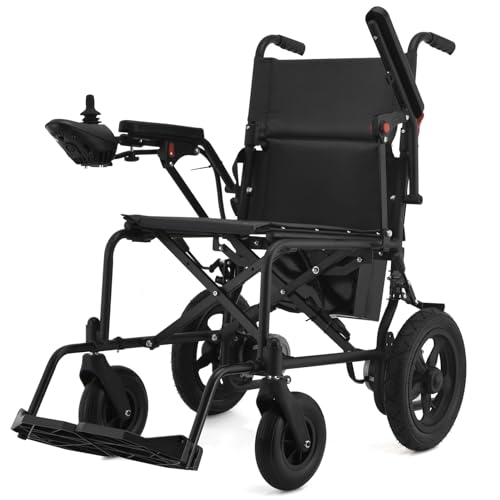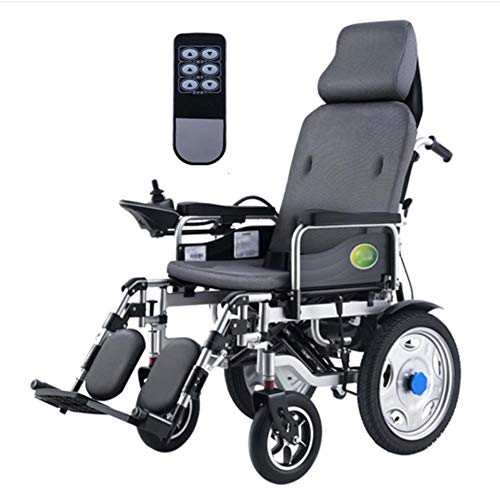Electric Wheelchair With Joystick: 11 Things You've Forgotten To Do
페이지 정보

본문
 Joysticks on lightweight power chairs wheelchairs can increase their ease of use and independence. However, standardized joysticks can be incompatible with the individualized features of hand dysfunction.
Joysticks on lightweight power chairs wheelchairs can increase their ease of use and independence. However, standardized joysticks can be incompatible with the individualized features of hand dysfunction. This study assessed the effectiveness and satisfaction of custom-designed power chairs for handicapped wheelchair joysticks made using 3D printing technology. Evaluation was conducted using the modified power-mobility inside driving assessment (PIDA), National Aeronautics and Space Administration Task Load Index and Psychosocial Impact of Assistive Devices Scale.
This study assessed the effectiveness and satisfaction of custom-designed power chairs for handicapped wheelchair joysticks made using 3D printing technology. Evaluation was conducted using the modified power-mobility inside driving assessment (PIDA), National Aeronautics and Space Administration Task Load Index and Psychosocial Impact of Assistive Devices Scale.Control
The control system for a power chair has two essential components: the joystick and the electronic. Standard joysticks often mount to the left or right sides of the chair, whereas more advanced rehab chairs could include swing-away mounts that allow for the joystick to be moved into the middle of the seat.
The manner in which a joystick is mounted and used is crucial to its success for a user. For instance, if an individual has significant tremors, it is crucial to ensure the joystick is designed in such a way that these movements will not trigger accidental activations of the chair. Standard EPW joysticks utilize proportional input devices which respond to the deflection of the gimbal in order to control the chair's motion (similar to the video game controller or automobile accelerator pedal).
There are many alternatives to controlling power wheelchairs that require a minimum of force to activate. Switch controls, sip-and puff controls, head arrays, and chin controls are all accessible. Some of these controls require an additional interface to connect to the wheelchair. However, a lot of them work with new joysticks which incorporate Bluetooth into the handles.
Some wheelchair joysticks have a screen to display the current status of the system and provide feedback to the user, which can be particularly useful for people who have visual or cognitive impairments. Other advanced joysticks have the capability of controlling various accessories, including environmental controls, and even a tablet or TV.
Whatever technology is employed, a joystick will only be as effective if the user feels easy to use. Therefore, it is crucial to think about the size and positioning of the joystick's buttons to ensure that they are easy to access. It is also important to consider the joystick's sensitivity which can be adjusted to a variety of levels according to the individual needs of the user.
Comfort
A joystick-controlled power chair provides many advantages that aren't offered by a manual chair. They reduce fatigue due to operational factors and can travel for longer distances than manual chairs. Additionally, they can be used in places with fewer spaces and more difficult terrain than a manual wheelchair for example, uneven surfaces or slopes in the outdoors. This increased independence allows users to experience the freedom of movement as well as a feeling of freedom.
There are a variety of power wheelchairs available each with its distinct features. The number of bells and whistles available on a specific model will depend on the needs of the user and desires. Some of the most popular features are:
Customization of controls on an best electric wheelchair uk (how you can help) wheelchair with the joystick is a possibility to satisfy the individual's needs. This includes the kind of knob or handle, as well as the ball or how it is mounted. Some joysticks are located at the end of the armrests of the driver's seat, while others are placed on the rear or front of the seat to make it easier for the an attendant to reach. Some joysticks can be mounted on the side for people who have limited shoulder mobility or muscle weakness.
Other features are more personalized like the design and size of the joystick's display. Some are backlit, or in the color of a display that is easier to read for people who have low vision. Other models have additional modes that provide visual or audio cues to help navigate. Other models could include odometers, clocks and indicators of battery charge.
Another crucial aspect of the joystick is how well it can be controlled in a tight turning radius. The most efficient models will have a precise turning radius that makes it easier to navigate obstacles in tight spaces, like hallways. This radius of tight turning makes it easier to navigate in public places and in stores. This tight turning circle is especially useful for people who have mobility issues, like cerebral palsy, or other mobility issues, like multiple sclerosis, ALS and Huntington's disease, spinal cord injury or brainstem stroke.
Safety
Power wheelchairs are designed with safety in mind. They have braking systems that are reliable that reduce speed rapidly when the user depresses the joystick control lever. They also have anti-tip wheels in the rear to stop the chair from sliding forward.
The most popular type of joystick is a proportional control which is similar to automobile accelerator pedals as well as video game controllers in that the more the joystick is moved away from its center the faster the wheelchair moves. Joysticks that are proportional require a strong hand and good proprioception to operate. A standard joystick is usually placed on the armrest, however, a variety special controls are available to put the controls in the middle or at the sides of the seat.
Some people may not have the strength to withstand the force of a joystick even with the help of special rigging. This is the case for those who have spasticity, which can cause muscles to become stiff or even die (atrophy). In these cases it is possible to use a head-control unit that converts the movements of the consumer's body into the appropriate commands for the wheelchair.
The size and position of the joystick's buttons is another factor to consider. If the buttons are too far to the left or difficult to reach, it could alter the user's sitting position and put strain on their hands. If the joystick is too far back, it may be difficult to maneuver the chair or turn the wheels.
The seatbelt should be fastened on an electric wheelchair. The most powerful wheelchairs can reach speeds up to 8 mph and a seatbelt that is not fastened could result in serious injuries or even death. Batteries should be charged frequently and, ideally, every night. This will ensure that they last longer and help maintain their effectiveness. You should also have your chair regularly maintained to ensure that all components are operating effectively.
Accessories
The joystick is a key component of any power wheelchair, and there are many accessories that can be added to enhance its functionality. They can range from basic switches, to more advanced interfaces that connect to communication devices, and even external environment control units. The higher-end power wheelchairs usually include a variety of controller components that can satisfy the requirements of different users. For example, a non-expandable controller will typically only accept a proportional joystick for an input device. However, an expandable controller can allow for puff and sip controls, special switches, and head array systems. Certain advanced controllers are capable of operating up to two power seating actuators which can adjust the position and angle of the seat.
The most commonly used type of joystick used in clinics is a proportional joystick also known as a movement-sensing joystick. This kind of joystick responds to force by increasing output (i.e. The speed of the wheelchair increases as the stick is moved away from the center. This requires a fair amount of intact proprioception and dexterity for effective use.
The technology of today is able to compensate for a small amplitude movement during EPW driving. However, it's not able to recognize and adjust for more severe unintentional motions, like those that cause larger amplitude tremors, or involuntary movements that aren't related to conscious intent like athetosis.
The majority of wheelchairs can be programmed and customized with the help from a medical professional. These parameters include changing the torque that is provided by the motor, altering the speed at which the chair moves and setting the dead zone that is the area within which the EPW will not generate an output. Some controllers allow the clinician to store backup programs. This is helpful in an emergency or when a patient's symptoms change.
- 이전글What's The Job Market For Gas Central Heating Engineers Near Me Professionals Like? 24.11.25
- 다음글11 Creative Methods To Write About Gas Fire Engineers Near Me 24.11.25
댓글목록
등록된 댓글이 없습니다.